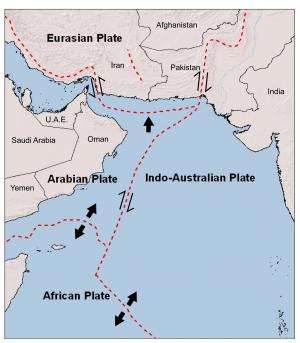

| Visitors Now: | |
| Total Visits: | |
| Total Stories: |

| Story Views | |
| Now: | |
| Last Hour: | |
| Last 24 Hours: | |
| Total: | |
Warning: Earthquakes Similar in Magnitude to the 2004 Sumatra Earthquake Could Occur in an Area Beneath the Arabian Sea at the Makran Subduction Zone
Monday, May 13, 2013 15:48
% of readers think this story is Fact. Add your two cents.
WARNING:Earthquakes Similar in Magnitude to the 2004 Sumatra Earthquake Could Occur in an Area Beneath the Arabian Sea at the Makran Subduction Zone.
Western Indian Ocean Earthquake and Tsunami Hazard Potential Greater than Previously Thought
Earthquakes similar in magnitude to the 2004 Sumatra earthquake could occur in an area beneath the Arabian Sea at the Makran subduction zone, according to recent research published in Geophysical Research Letters.

The location of the Makran subduction zone of Pakistan and Iran and locations of recorded earthquakes including the 1945 magnitude 8.1 earthquake (red dot to the north indicates the 1947 magnitude 7.3 earthquake). The profile for the thermal modelling of this study is the N-S trending black line, with distance given along the profile from the shallowest part of the subduction zone in the south (0 kilometers) to the most northern potential earthquake rupture extent (350 kilometers). Credit: University of Southampton Ocean and Earth Science
The research was carried out by scientists from the University of Southampton based at the National Oceanography Centre Southampton (NOCS), and the Pacific Geoscience Centre, Natural Resources Canada.
The study suggests that the risk from undersea earthquakes and associated tsunami in this area of the Western Indian Ocean – which could threaten the coastlines of Pakistan, Iran, Oman, India and potentially further afield – has been previously underestimated.
The results highlight the need for further investigation of pre-historic earthquakes and should be fed into hazard assessment and planning for the region.
Subduction zones are areas where two of the Earth’s tectonic plates collide and one is pushed beneath the other.
When an earthquake occurs here, the seabed moves horizontally and vertically as the pressure is released, displacing large volumes of water that can result in a tsunami.

This shows the primary tectonic plates and plate boundaries in the Arabian Sea region and the geographic context. Credit: University of Southampton Ocean and Earth Science
The Makran subduction zone has shown little earthquake activity since a magnitude 8.1 earthquake in 1945 and magnitude 7.3 in 1947.
Because of its relatively low seismicity and limited recorded historic earthquakes it has often been considered incapable of generating major earthquakes.
Plate boundary faults at subduction zones are expected to be prone to rupture generating earthquakes at temperatures of between 150 and 450 °C.
The scientists used this relationship to map out the area of the potential fault rupture zone beneath the Makran by calculating the temperatures where the plates meet. Larger fault rupture zones result in larger magnitude earthquakes.
Journal reference: Geophysical Research Letters
Provided by National Oceanography Centre, Southampton
Read more at:


